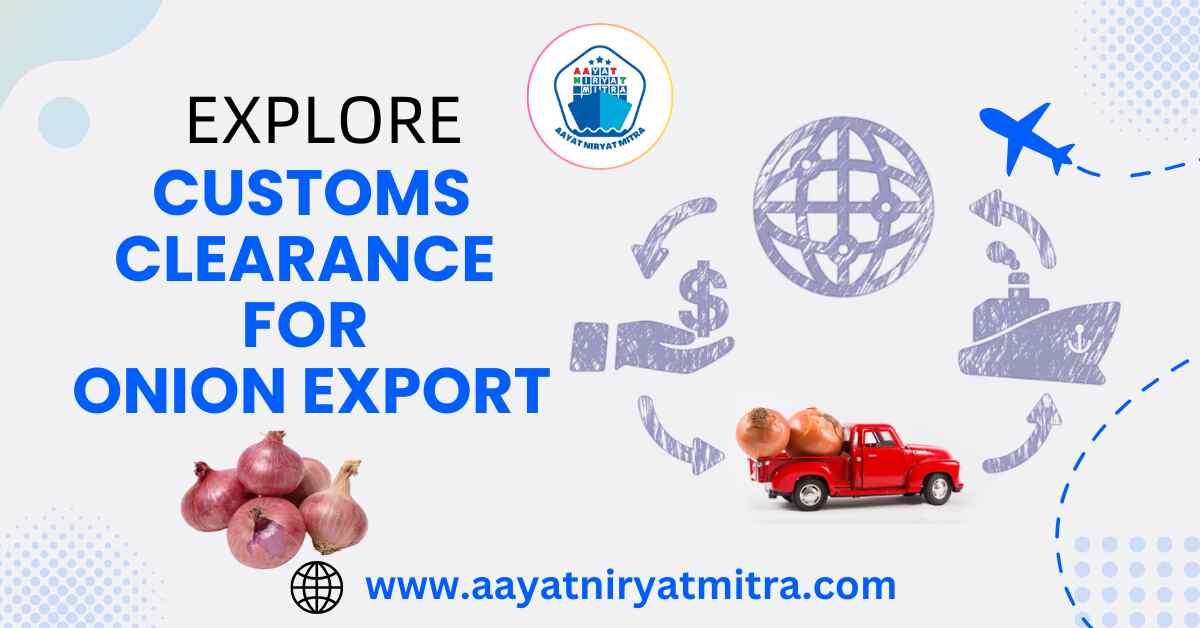Onion Exports, especially from India, are more than just harvesting and shipping. It involves navigating a maze of processes, with customs clearance being one of the trickiest stages. A misstep here can cause delays, losses, and missed opportunities. So, in this guide, we’ll walk you through the essentials to ensure your onions get through customs smoothly and onto the global market without a hitch.
Getting the Onion Exports Process Right:
Before we dive into customs clearance, it’s important to understand the bigger picture of the onion export journey:
- Sourcing and Procurement: The first step is to secure high-quality onions from reliable farmers.
- Grading and Packaging: Next, you’ll sort the onions based on size and quality. Once sorted, they need to be packed according to market standards.
- Documentation: Here’s where paperwork comes in—everything from invoices to export permits, and the crucial phytosanitary certificate proving your onions are pest-free.
- Transportation: Based on where the onions are heading and their perishability, you’ll need to decide whether to send them by sea, air, or land.
- Customs Clearance: This is where the real action happens—inspections, document checks, and duty payments.
Customs Clearance and Why It’s Critical:
Customs clearance is essentially the process where authorities inspect your onions to make sure everything matches up—quality, quantity, and compliance with laws. In the case of onion exports, this involves several key steps:
- Inspection: Officials will physically inspect the onion shipment to make sure it matches what you’ve declared.
- Document Verification: They’ll go over all your paperwork with a fine-tooth comb to ensure it’s complete and accurate.
- Duty Payment: Any applicable export duties or taxes need to be calculated and paid.
- Licenses and Permits: Customs officials will check that you have the necessary permits, such as the phytosanitary certificate confirming that your onions are disease-free.
Key Documents for Onion Export Customs Clearance:
Having the right documents ready is half the battle. Here’s what you’ll need:
- Commercial Invoice: Lists out the value, quantity, and description of your onions.
- Packing List: Details the contents and packaging of your shipment.
- Bill of Lading: Issued by your shipping company, this document is your contract of carriage.
- Phytosanitary Certificate: Confirms that your onions are free of pests and diseases.
- Export Permit: Issued by the government, this allows you to export the onions legally.
- Certificate of Origin: Verifies the onions’ country of origin.
Tips for Hassle-Free Customs Clearance:
Here are some practical tips to help smooth out the process:
- Get Your Paperwork in Order: Double and triple-check that your documents are accurate, complete, and up-to-date.
- Be Clear About Your Product: Provide detailed descriptions of your onions, including their variety, size, and quality.
- Stay Compliant: Make sure you’re following both Indian export regulations and those of the destination country.
- Choose the Right Freight Forwarder: A skilled freight forwarder can help navigate the customs process more smoothly.
- Build Good Relationships: Maintaining good relationships with customs officials can sometimes make the process quicker.
- Consider a Customs Broker: For more complicated shipments, a customs broker can be worth their weight in gold.
Common Challenges (And How to Overcome Them):
Of course, even the best-laid plans can hit a few bumps along the way. The following difficulties are possible for you, along with solutions:
- Documentation Errors: Always double-check your documents for accuracy before submitting them. Simple errors might cause a waste of time
- Unexpected Delays: Build in some buffer time to account for any unforeseen setbacks. It’s better to be safe than sorry.
- Inspection Issues: If you maintain high standards for your onions from the start, you’ll reduce the risk of issues cropping up during inspections.
Resources for Indian Exporters:
- Ministry of Commerce and Industry, India
- Federation of Indian Export Organisations (FIEO)
- Export Credit Guarantee Corporation (ECGC)
- Indian Trade Promotion Organisation (ITPO)
- Embassy and Consulates of India in African countries
FAQs On Customs Clearance for Onion Exports:
-
Q: What essential documents do I need for onion export customs clearance?
Ans: To successfully clear customs, you’ll need the following key documents:
1. Bill of Lading (BoL)
2. Commercial Invoice
3. Packing List
4. Certificate of Origin
5. Phytosanitary Certificate
6. Export License (if needed)
7. Customs Declaration Form
Having all these in order will ensure a smoother process. -
Q: How can I get a phytosanitary certificate for my onion exports?
Ans: To obtain a phytosanitary certificate:
Reach out to your local agricultural department or plant quarantine authority.
Share details about your onion shipment, like its origin, destination, and quantity.
Your onion fields will be inspected to ensure they meet health standards.
After the inspection, you’ll pay a fee and receive the certificate. -
Q: What duties and taxes will I need to pay for exporting onions?
Ans: Customs duties vary based on the destination country and any trade agreements in place. It’s a good idea to consult the customs authority in the importing country to get the exact rates. Keep in mind that additional taxes, like VAT or sales tax, might also apply.
-
Q: What could delay or get my onion export rejected at customs?
Ans: Some common reasons include:
Incomplete documentation or failure to comply with import regulations.
Pest or disease infestation in the onions.
Poor quality standards.
Incorrect declaration of product value or quantity.
To avoid delays, it’s crucial to follow regulations carefully and ensure high product quality. -
Q: How can I make sure the customs clearance process for my onion exports goes smoothly?
Ans: Some tips to ensure a hassle-free process:
Plan and submit all documents early.
Ensure your onions meet the quality standards of the importing country.
Partner with a trusted customs broker or freight forwarder.
Stay informed about changes in import regulations or trade policies. -
Q: What role does a customs broker play in onion exports?
Ans: A customs broker can be your best ally in navigating customs procedures. They will:
Assist with the necessary paperwork.
Submit your documents to the right authorities.
Represent you in front of customs officials.
Guide import regulations and duties. -
Q: How long does customs clearance usually take for onion exports?
Ans: The time frame depends on various factors, such as the size of your shipment, whether your documents are in order, and the level of inspection required. It could take a few days to many weeks on average.
-
Q: What are some risks involved with exporting onions?
Ans: Exporting onions comes with a few risks, including:
Market fluctuations and price volatility.
The perishable nature of onions.
Possible trade restrictions and tariffs.
The risk of quality issues leading to shipment rejection. -
Q: When is the best time of year to export onions?
Ans: The ideal export season depends on the type of onions you’re exporting and the demand in your target market. It’s a good idea to consult industry experts or look into market research to find the perfect timing.
-
Q: How can I minimize the risk of onion spoilage during export?
Ans: To prevent spoilage, here are some best practices:
Use proper packaging to protect onions from damage and moisture.
Maintain the right temperature and humidity levels during transport.
Consider cold storage if needed.
Work with experienced shipping partners who know how to handle perishable goods.
Conclusion:
Exporting onions successfully takes careful planning and strict attention to international rules. One of the most important steps in this process is clearing customs, which often involves a lot of paperwork and detailed procedures. By getting familiar with the key parts of customs clearance—like the necessary documents, common challenges, and the helpful role customs brokers play—onion exporters can simplify the process and ensure their shipments go smoothly.
If you discover an error in the “Navigating Customs Clearance for Onion Exports: A Step-by-Step Guide in 2025“ information provided to us, please notify us immediately via the comment box and email; if the information provided by you is correct, We will change it.
If you enjoyed this article, please share it with your friends. Please visit Aayat Niryat Mitra | Import Export Friend for more information on this and other topics. Thank you for stopping by.

